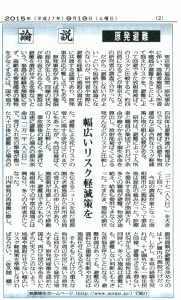Original Japanese written by staffer
The English below translated from the original Japanese by Heeday
The English translation edited by Rev. Dr. Henry French, ELCA
(Source: article of September 19th, 2015 edition of the Fukushima Minpo newspaper)
▼Click the image to enlarge it and read the caption.

Following the meltdown of TEPCO’s Fukushima Daiichi Nuclear Power Plant (NPP), numerous residents and employees of facilities for the elderly were evacuated from the NPP’s vicinity. This evacuation, needless to say, freed them from the risk posed by radiation. The evacuation, however, exposed them to other kinds of risk, which are almost 400 times greater than that from radiation, according to an academic paper published in the U.S. science journal POS ONE by a study team consisting of scientists from the University of Tokyo and other institutions. To elderly people, many of whom suffer from disabilities and/or a chronic disease, emergency evacuation can mean risks to their wellbeing far greater than those from radiation. Thus, according to the study, evacuation can shorten their lives.
Needless to say, however, no one can claim that such people should remain in the radioactive areas. This is one of the highly troublesome complexities accompanying a NPP accident. A member of the study team, Mr. Michio Murakami, currently an associate professor at Fukushima Medical University and formerly an assistant professor at the Institute of Industrial Science at the University of Tokyo, says, “We need to develop and prepare less burdensome means of transportation and facilities to evacuate to. Also, such facilities need to be equipped with medicines and food. Then, we should be able to reduce the accompanying risk.”
Shortly after the Fukushima Daiichi meltdown began, among those facility residents and hospitalized patients being evacuated, one victim after another passed away in the confusion accompanying the sudden evacuation. Many consider those deaths ascribable to physical and mental stress, burdens accompanying the evacuation, and insufficient medical care.
When the Sendai NPP was restarted, the prefectural government of Kagoshima specified evacuation destinations only for those facilities within 10km (6.2 miles) of the NPP. Learning from the tragedy of Fukushima, however, we see that there is a high probability that many facilities outside the 10km radius may also face the need for evacuation. This means that many such facilities could face the very tough decision of running away from a disaster or not.
If another NPP disaster hits and creates a situation similar to that of Fukushima, such facilities say they will have to choose to evacuate. Any facility for the elderly located close to a NPP needs to prepare many emergency measures to secure the safety of its residents and employees.
Starting with Sendai’s restart, Japan is reverting to a country powered by NPPs. This means we might face another NPP tragedy at any time. We need to learn lessons from the Fukushima Daiichi disaster. One urgent task is to develop and prepare a great variety of risk-reduction measures in case of a NPP accident. Otherwise, such an accident could shorten the lives of many.
